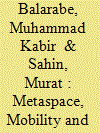|
|
|
Sort Order |
|
|
|
Items / Page
|
|
|
|
|
|
|
| Srl | Item |
| 1 |
ID:
118685


|
|
|
|
|
| Publication |
2013.
|
| Summary/Abstract |
Despite the existence of an administration - the chengguan - one of whose main roles is to control illegal street vendors, the latter are still very numerous in Beijing. This paradox can be partly explained by a form of tolerance on the part of the chengguan in response to the public resistance to their actions, which is linked to the conflictive nature of their relationship with the street vendors. This tolerance appears to be erratic, but is actually based on recurrent distinctions made by this administration. However, the informal, revocable, and ultimately unpredictable character of the control exercised by the chengguan has resulted in a continuation of the conflictive nature of their interactions with street vendors.
|
|
|
|
|
|
|
|
|
|
|
|
|
|
|
|
| 2 |
ID:
175108


|
|
|
|
|
| Summary/Abstract |
The street vendor’s (SV) potential mobility in subverting authorities’ hegemony over public space has been theorised within the contexts of urban informality and resistance. Discussions mainly revolve around movement tactics as resistance strategy while evading arrests and confiscations. This negates SV agency and limits understanding mobility in resistance. Using Bunschoten’s metaspace and Cresswell’s aspects of mobility, this paper employs semi-structured interviews with mobile SV, road users and pedestrians in Kano (Nigeria), to describe vendors’ mobile practices and how they delay hostility from the state. Observing the interplay between vendors, users and environment, this paper identifies four types of vendor movement: focused, targeted, sporadic and self-regulatory; and examines how vendors exploit Cresswell’s speed and rhythm in challenging formal urban practice hegemony through continuous operation. The paper also describes how vendors’ movement affects other actors’ mobilities. Finally, the paper discusses urban design implications for integrating SV within city plans, setting out potential proposals.
|
|
|
|
|
|
|
|
|
|
|
|
|
|
|
|
| 3 |
ID:
146513


|
|
|
|
|
| Summary/Abstract |
Conflicts between urban street vendors and city regulators have become a common urban sight in Chinese cities today. This paper considers how visions of modern urban streets and sidewalks have helped to generate increasingly restrictive policies on street vending and spurred new forms of urban regulation and policing. While mostly an everyday routine of Chinese city life, the resulting vendor–chengguan conflicts dramatize state power in public and carry the latent danger of crowd violence in response. In particular, aggressive policing of highly visible city streets can at times produce a volatile “politics of the street” involving episodes of vendor resistance and even dramatic expressions of bystander solidarity which challenge these street-level expressions of state power.
|
|
|
|
|
|
|
|
|
|
|
|
|
|
|
|
| 4 |
ID:
190820


|
|
|
|
|
| Summary/Abstract |
This article points out the need to talk about the political society, or the politics and resistances, of subaltern groups in Eastern Europe and Eurasia. Existing literature frames diversity marginalized struggles as civil society struggles or decries the weakness of donor-driven, disembedded civil societies, reproducing the understanding of political life in the region in terms of absences, voids and deficiencies. Challenging this subsumption or dismissal of subaltern struggles, I advance two arguments. First, I argue against broadening the civil society concept to include various subaltern struggles as this approach risks overwriting differences between those groups that mobilize as rights-bearing citizens and the ones that are not recognized or treated as civil society. Instead, I propose acknowledging the historically and spatially contingent character of civil society and the defining role of the state and other actors in shaping which struggles fall within or beyond institutional and discursive frameworks of legality and legitimacy. Second, I argue that Patra Chatterjee’s concept of ‘political society’ can serve better as a meta-vocabulary to account for a diversity of struggles shunted as backwards, premodern and uncivilized, and to refocus research from what is absent to what is present, towards understanding counter-hegemonic discourses and practices.
|
|
|
|
|
|
|
|
|
|
|
|
|
|
|
|
|
|
|
|
|